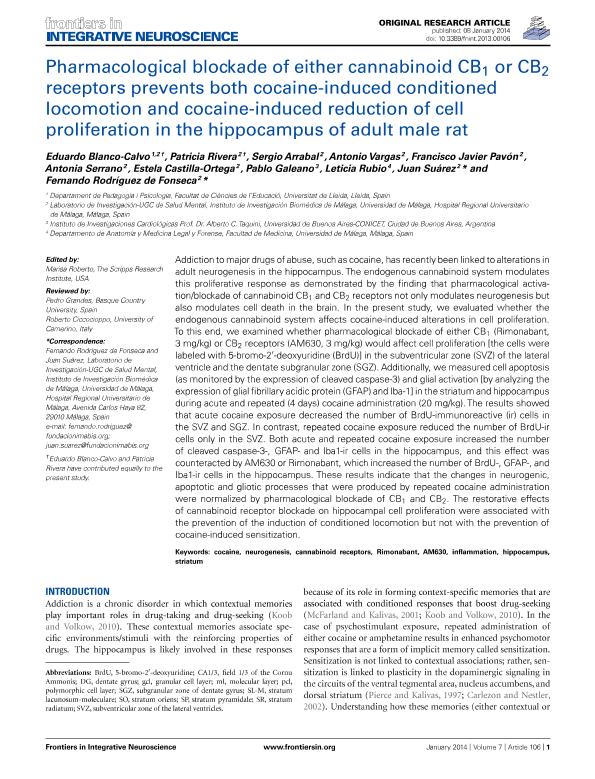Mostrar el registro sencillo del ítem
dc.contributor.author
Blanco Calvo, Eduardo
dc.contributor.author
Rivera, Patricia
dc.contributor.author
Arrabal, Sergio
dc.contributor.author
Vargas, Antonio
dc.contributor.author
Pavon, Francisco Javier
dc.contributor.author
Serrano, Antonia
dc.contributor.author
Castilla Ortega, Estela
dc.contributor.author
Galeano, Pablo

dc.contributor.author
Rubio, Leticia
dc.contributor.author
Suaréz, Juan
dc.contributor.author
Rodríguez de Fonseca, Fernando
dc.date.available
2016-11-01T21:13:25Z
dc.date.issued
2014-01
dc.identifier.citation
Blanco Calvo, Eduardo; Rivera, Patricia; Arrabal, Sergio; Vargas, Antonio; Pavon, Francisco Javier; et al.; Pharmacological blockade of either cannabinoid CB1 or CB2 receptors prevents both cocaine-induced conditioned locomotion and cocaine-induced reduction of cell proliferation in the hippocampus of adult male rats; Frontiers; Frontiers in Integrative Neuroscience; 7; 106; 1-2014; 1-13
dc.identifier.issn
1662-5145
dc.identifier.uri
http://hdl.handle.net/11336/7900
dc.description.abstract
Addiction to major drugs of abuse, such as cocaine, has recently been linked to alterations in adult neurogenesis in the hippocampus. The endogenous cannabinoid system modulates this proliferative response as demonstrated by the finding that pharmacological activation/blockade of cannabinoid CB1 and CB2 receptors not only modulates neurogenesis but also modulates cell death in the brain. In the present study, we evaluated whether the endogenous cannabinoid system affects cocaine-induced alterations in cell proliferation. To this end, we examined whether pharmacological blockade of either CB1 (Rimonabant, 3 mg/kg) or CB2 receptors (AM630, 3 mg/kg) would affect cell proliferation (the cells were labeled with BrdU) in the subventricular zone (SVZ) of the lateral ventricle and the dentate subgranular zone (SGZ). Additionally, we measured cell apoptosis (as monitored by the expression of cleaved caspase-3) and glial activation (by analyzing the expression of GFAP and Iba-1) in the striatum and hippocampus during acute and repeated (4 days) cocaine administration (20 mg/kg). The results showed that acute cocaine exposure decreased the number of BrdU-immunoreactive (ir) cells in the SVZ and SGZ. In contrast, repeated cocaine exposure reduced the number of BrdU-ir cells only in the SVZ. Both acute and repeated cocaine exposure increased the number of cleaved caspase-3-, GFAP- and Iba1-ir cells in the hippocampus, and this effect was counteracted by AM630 or rimonabant, which increased the number of BrdU-, GFAP- and Iba1-ir cells in the hippocampus. These results indicate that the changes in neurogenic, apoptotic and gliotic processes that were produced by repeated cocaine administration were normalized by pharmacological blockade of CB1 and CB2. The restorative effects of cannabinoid receptor blockade on hippocampal cell proliferation were associated with the prevention of the induction of conditioned locomotion but not with the prevention of cocaine-induced sensitization.
dc.format
application/pdf
dc.language.iso
eng
dc.publisher
Frontiers

dc.rights
info:eu-repo/semantics/openAccess
dc.rights.uri
https://creativecommons.org/licenses/by/2.5/ar/
dc.subject
Cocaina
dc.subject
Neurogenesis
dc.subject
Cannabinoid Receptors
dc.subject
Rimonabant
dc.subject
Am630
dc.subject
Inflammation
dc.subject
Hippocampus
dc.subject
Striatum
dc.subject.classification
Neurociencias

dc.subject.classification
Medicina Básica

dc.subject.classification
CIENCIAS MÉDICAS Y DE LA SALUD

dc.title
Pharmacological blockade of either cannabinoid CB1 or CB2 receptors prevents both cocaine-induced conditioned locomotion and cocaine-induced reduction of cell proliferation in the hippocampus of adult male rats
dc.type
info:eu-repo/semantics/article
dc.type
info:ar-repo/semantics/artículo
dc.type
info:eu-repo/semantics/publishedVersion
dc.date.updated
2016-08-30T17:09:49Z
dc.journal.volume
7
dc.journal.number
106
dc.journal.pagination
1-13
dc.journal.pais
Suiza

dc.journal.ciudad
Lausanne
dc.description.fil
Fil: Blanco Calvo, Eduardo. Universitat de Lleida; España
dc.description.fil
Fil: Rivera, Patricia. Universidad de Malaga; España
dc.description.fil
Fil: Arrabal, Sergio. Universidad de Malaga; España
dc.description.fil
Fil: Vargas, Antonio. Universidad de Malaga; España
dc.description.fil
Fil: Pavon, Francisco Javier. Universidad de Malaga; España
dc.description.fil
Fil: Serrano, Antonia. Universidad de Malaga; España
dc.description.fil
Fil: Castilla Ortega, Estela. Universidad de Malaga; España
dc.description.fil
Fil: Galeano, Pablo. Consejo Nacional de Investigaciones Científicas y Técnicas. Oficina de Coordinación Administrativa Houssay. Instituto de Investigaciones Cardiológicas (i); Argentina
dc.description.fil
Fil: Rubio, Leticia. Universidad de Malaga; España
dc.description.fil
Fil: Suaréz, Juan. Universidad de Malaga; España
dc.description.fil
Fil: Rodríguez de Fonseca, Fernando. Universidad de Malaga; España
dc.journal.title
Frontiers in Integrative Neuroscience
dc.relation.alternativeid
info:eu-repo/semantics/altIdentifier/url/https://www.ncbi.nlm.nih.gov/pmc/articles/PMC3884150/
dc.relation.alternativeid
info:eu-repo/semantics/altIdentifier/url/http://journal.frontiersin.org/article/10.3389/fnint.2013.00106/full
dc.relation.alternativeid
info:eu-repo/semantics/altIdentifier/doi/http://dx.doi.org/10.3389/fnint.2013.00106
Archivos asociados
